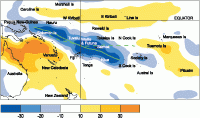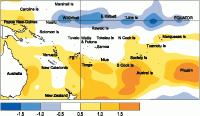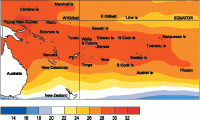Climate developments in February 2006

The SPCZ was rather active, extending from the region north of the Solomon Islands southeast towards the Southern Cook Islands, resulting in enhanced convection and/or above average rainfall over parts of Tuvalu, Wallis and Futuna, northern Fiji, northern Tonga, Samoa, and the Southern Cook Islands. The SPCZ was located near its average position about and west of the Date Line, but further south than average in the east.
A large region of strongly suppressed convection affected Queensland, extending east towards Vanuatu. Weakly suppressed convection persisted over Western and Eastern Kiribati in the central equatorial Pacific.
Rainfall was more than 300% of average in northern parts of Tonga, more than 250% of average in parts of Samoa (over 1000 mm in Apia), and at least 125% of average in Fiji’s Rotuma Island and the Southern Cook Islands. High rainfall totalling almost 200 mm occurred in Labasa, Fiji, towards the end of February, resulting in landslides. There were three fatalities. In contrast, February rainfall was less than 50% of average in parts of Western and Eastern Kiribati, and less than 25% of average in several northern regions of New Zealand.
Mean air temperatures were 0.5 °C or more above average throughout much of French Polynesia.
Southwest Pacific mean sea-level pressures tended below average over much of the tropical Pacific about and east of Vanuatu, the largest negative anomalies being south of the Cook Islands. Equatorial surface easterlies continued to be very persistent along the Equator, occurring in about 99% of observations at Tarawa.
| Country | Location | Monthly Rainfall (mm) | % of average | Comments |
|---|---|---|---|---|
| Tonga | NiuaFoo’u | 846 | 340 | Record high |
| Samoa | Apia | 1029 | 279 | Record high |
| Eastern Kiribati | Kiritimati | 15 | 21 | Well below normal |
| Australia | Lord Howe Island | 21 | 18 | Extremely low |
| New Zealand | Auckland Airport | 7 | 9 | Record low |


The state of the tropical Pacific Ocean and atmosphere remains characteristic of weak La Niña conditions, though the one-month Southern Oscillation Index (SOI) has returned to near zero for February. The region of strongest negative sea surface temperature (SST) anomalies continued to migrate westwards in February, weakening as it approached the Date Line. The NINO3 SST anomaly was about 0.3°C for February (-0.4°C in January, -0.5°C for December-February) and NINO4 fell to -0.7°C (-0.3°C in January and for December-February). At around 100 m depth, the negative temperature anomaly seen earlier near 140°W moved eastwards to be centred near 120°W, while a positive anomaly strengthened west of the Date Line. SPCZ-related convection was enhanced in February from the Solomon Islands, and out across the region of Fiji and Samoa towards the southeast, while convection was suppressed over northern Australia and the Coral Sea, and in the equatorial belt east of the Date Line. A region of Madden-Julian Oscillation (MJO) related convection should move through the Indonesian region over the coming two weeks.
Most El Niño/Southern Oscillation global forecast models are on the cool side of neutral conditions for autumn, with three showing La Niña conditions. All models tend back towards neutral conditions by mid-year, with considerable spread in the forecasts after that. The latest NCEP/CPC statement calls for La Niña conditions during the next 3-6 months, while the IRICP summary gives a 65% chance of La Niña conditions over the next three months, reducing to 20% by mid year.
